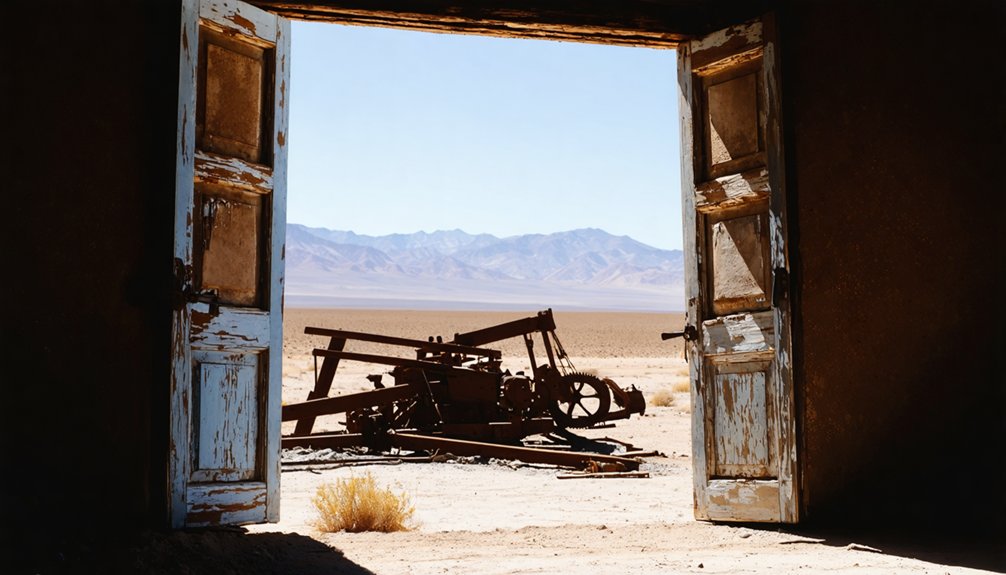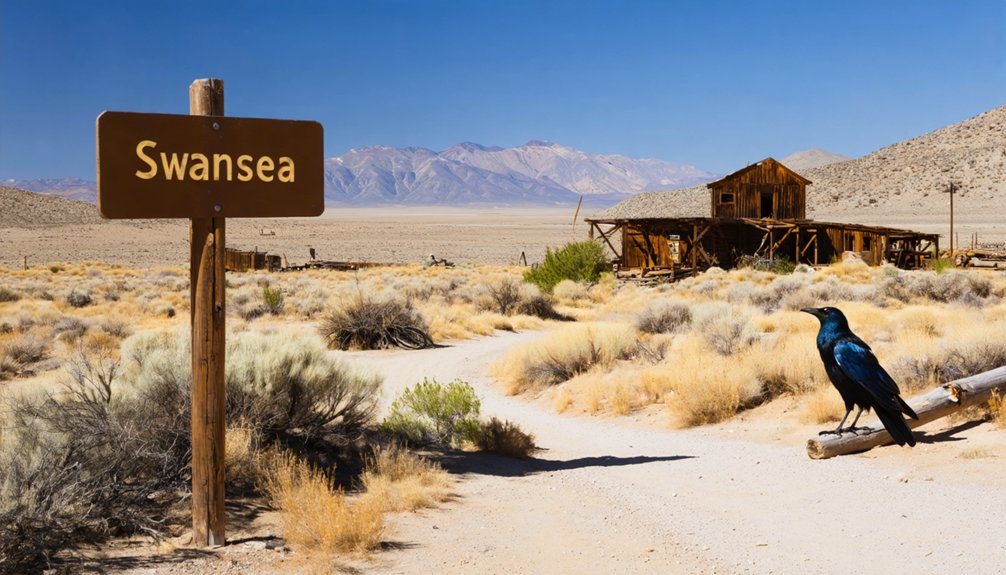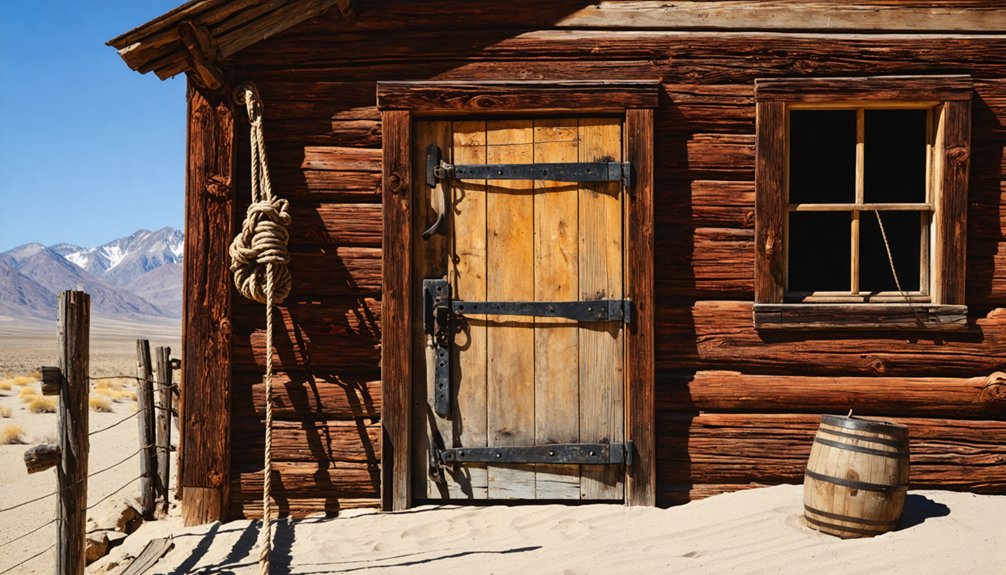Swansea, a California ghost town established in 1870 by James Brady, once thrived as a silver processing hub on Owens Lake with 2,200 residents. You’ll find remnants of its industrial past, including smelter ruins and foundations marked as California Historical Landmark No. 752. The town’s decline began with the 1872 Lone Pine Earthquake and worsened when a thunderstorm buried it in debris by 1874. The site’s remote desert location reveals much about the West’s boom-bust mining cycle.
Key Takeaways
- Swansea was a California mining town established in 1870 that processed silver from Cerro Gordo mines into approximately 150 silver bars daily.
- The town, named for its Welsh mining heritage, reached a peak population of 2,200 before its decline.
- A devastating earthquake in 1872 and a destructive thunderstorm in 1874 led to Swansea’s abandonment.
- Recognized as California Historical Landmark No. 752, Swansea exemplifies the boom-bust cycle common in Western mining towns.
- Visitors require high-clearance vehicles to access the remote ghost town, which features architectural ruins against a desert landscape.
The Silver Smelting Town on Owens Lake
The shimmering waters of Owens Lake once supported a vital hub of industrial activity at Swansea, established in 1870 by entrepreneur James Brady.
The shimmering waters of Owens Lake created a cradle for industrial innovation where Swansea’s silver dreams took flight.
This settlement emerged after Brady took over the Silver-Lead Furnace originally constructed by Col. Sherman Stevens in 1869. You’ll find that Swansea’s prosperity depended entirely on its smelting techniques, which processed ore from the Cerro Gordo mines into impressive quantities—about 150 silver bars every 24 hours, each weighing 83 pounds.
Charcoal production formed the backbone of Swansea’s operations. The fuel came from Cottonwood Canyon kilns, transported across the lake by steamship. The lake’s maximum depth of 3 feet presented challenges for shipping operations during dry periods. The furnace was eventually recognized as California Historical Landmark No. 752 for its significance in the region’s mining history.
This intricate system functioned until March 1874, when flash flooding damaged the docks, accelerating Swansea’s decline and Keeler’s rise as the region’s primary smelting center.
A Journey Through Time: Swansea’s 1870 Origins
When James Brady established Swansea in 1870 after acquiring the Silver-Lead Furnace operations, he set in motion the development of what would become a bustling industrial hub on Owens Lake’s northern shore.
The town’s name reflected its Welsh mining heritage, purposefully echoing the famous smelting town in South Wales.
Swansea’s history centers on the strategic processing of silver ore from the Cerro Gordo Mines. As this mining community flourished, its population swelled to 2,200 residents.
The town’s industrial capacity was impressive—its two smelters produced approximately 150 silver bars daily, each weighing 83 pounds.
The infrastructure included a 1,200-foot slag wharf, the community-centered Case Hall, and numerous residential structures that supported the workers.
This rapid growth characterized Swansea’s early years, though its prosperity would prove short-lived. The Lone Pine Earthquake of 1872 would mark the beginning of the town’s decline by damaging critical infrastructure.
The furnace operations that defined Swansea’s economic purpose continued until March 1874, when mining activities in the area began to decrease significantly.
The James Brady Legacy and Silver-Lead Company
James Brady’s visionary leadership transformed Swansea into a silver-processing powerhouse during the early 1870s, establishing an industrial legacy that would shape California’s mining landscape for decades.
When Brady purchased the Owens Lake Silver-Lead operation in 1870, he named it after Wales’ renowned smelting center and immediately implemented revolutionary Brady’s innovations. His most significant contribution was the 85-foot steamer *Bessie Brady*, which slashed ore transportation time across Owens Lake from three days to just three hours, dramatically reducing costs.
Brady revolutionized Owens Lake mining with his 85-foot steamer, transforming a three-day journey into a mere three-hour transport.
Under Brady’s direction, advanced smelting techniques flourished, including crushing, amalgamation with mercury-coated copper plates, and improved fluxing methods.
The devastating Lone Pine earthquake of 1872 severely damaged Swansea’s smelters, ultimately leading to operations being shifted to nearby Keeler.
His furnace produced impressive output—including 150 silver bars weighing 83 pounds each—cementing Swansea’s reputation as the region’s premier silver-lead processing hub from 1869 to 1874.
Brady’s operation faced significant challenges when he became embroiled in legal disputes with Belshaw over mining rights, despite winning a court argument but eventually losing the valuable shipping contract.
Industrial Ruins: What Remains of the Smelters
Scattered across the harsh Owens Lake landscape, industrial remnants of Swansea’s once-thriving smelting operations now stand as weathered sentinels of California’s mining past.
The smelter architecture reveals fragments of the original Silver-Lead furnace about 10 miles south of Lone Pine on Highway 136, marked by a stone monument.
You’ll find these industrial heritage elements throughout the site:
- Crumbling masonry walls and furnace fragments displaying 1870s metal refining technology
- Connecting pathways between the main smelter, dust collector, and manager’s house
- Tailing piles and mining debris that illustrate period-specific waste disposal methods
The site reflects the harsh life conditions of early 1900s miners who worked in these challenging environments.
The silver smelting operations ceased permanently in March 1874 after natural disasters severely damaged the facilities and disrupted shipping routes.
Despite ongoing natural degradation and vandalism, these fragile ruins provide tangible connections to Western mining’s pivotal role in regional development.
The site remains largely unprotected, relying on your respect to preserve this historical treasure.
The Rise and Fall of a 2,200-Person Boomtown
Founded in 1870 on the edge of Owens Lake, Swansea rapidly transformed from a barren stretch of desert into a bustling 2,200-person industrial center. Named after the Welsh smelting capital, the town’s economy revolved entirely around processing silver ore from the nearby Cerro Gordo Mines.
Swansea’s historical significance lies in its innovative transportation system—the 1,200-foot slag wharf and steamship “Bessie Brady” reduced ore transport time across the lake from three days to mere hours. The town flourished with stagecoaches, saloons, and stores until nature intervened dramatically.
The devastating one-two punch of the 1872 Lone Pine earthquake and catastrophic 1874 flooding buried Swansea’s ambitions. The town was established by Colonel Sherman Stevens who developed it specifically as an ore processing center. The local mining economy extracted an impressive 27 million pounds of copper during its operational period. Within four years of reaching its peak, the town stood abandoned, its residents relocating to Keeler—a stark reminder of the West’s ephemeral boom-bust cycle.
Connecting to Cerro Gordo: Mining Relationships
Though geographically separate, Swansea and Cerro Gordo functioned as symbiotic entities in a complex mining ecosystem that transformed the Owens Valley landscape.
Mortimer Belshaw’s strategic vision established critical Cerro Gordo connections through his superior smelting operations and transportation infrastructure.
When you examine this relationship, you’ll find it hinged on three essential elements:
- Belshaw’s Yellow Road toll route that controlled ore movement between the remote mountain mines and lakeside smelters
- The strategic placement of advanced furnaces in Swansea to process Cerro Gordo’s silver-lead ores at scale
- The innovative use of steamboat transport across Owens Lake, eliminating 40+ miles of difficult wagon travel
This mining infrastructure network allowed both settlements to thrive despite harsh conditions, creating an efficient production chain from extraction to market.
Environmental Changes That Doomed Swansea

Owens Lake’s dramatic desiccation devastated Swansea’s already precarious existence by eliminating the water source critical for both daily operations and transportation logistics.
You’ll notice how mining debris accumulated over decades, transforming the natural landscape into a scarred terrain unsuitable for sustained habitation or agriculture.
The region’s harsh desert climate, featuring scorching summers and minimal rainfall, ultimately accelerated the physical deterioration of structures and made living conditions increasingly untenable for the remaining population.
Owens Lake’s Fatal Drying
Once a vibrant body of water sustaining the surrounding ecosystem, Owens Lake transformed into a toxic dust bowl following the massive water diversions orchestrated by Los Angeles in the early 20th century.
When you visit today, you’ll see one of America’s most dramatic environmental disasters—a desiccated basin that became the nation’s largest source of PM10 dust emissions by 2000, releasing over 62,000 tons of particulate matter annually.
The LADWP has since invested $2.5 billion in lake restoration efforts that include:
- Shallow flooding techniques keeping 75% of treated surfaces wet
- Managed vegetation serving as natural windbreaks
- Gravel placement and soil tillage to minimize airborne particles
These interventions have reduced dust emissions by 99.4%, though the ecological damage to Swansea’s surroundings remains catastrophic.
Mining Debris Altered Landscape
While Owens Lake’s desiccation delivered a devastating blow to the region, the accumulation of mining debris around Swansea proved equally destructive to the town’s environmental viability.
You’d scarcely recognize the original topography beneath massive waste rock deposits from the Keeler Dunes and Owens Lake Soda Ash Company operations.
This landscape degradation triggered cascading ecological consequences.
Mining impacts included burial of native vegetation, disruption of natural drainage patterns, and creation of unstable, dust-prone areas. The altered terrain became a significant source of PM10 emissions, regularly blanketing the town in harmful particulates that violated National Ambient Air Quality Standards.
Debris-laden runoff carried heavy metals into water sources, while accumulated sediment blocked drainage channels, increasing flash flood risks.
These environmental changes created an inhospitable setting where both human health and ecological stability became unsustainable.
Climate Hastened Town’s Collapse
As Swansea teetered on the brink of abandonment, severe environmental stressors accelerated its demise through a perfect storm of climate-related challenges. The town’s ecological resilience challenges multiplied after the 1872 Lone Pine Earthquake lifted Owens Lake’s shoreline, rendering Swansea’s pier useless and compromising essential mining infrastructure.
Climate variability effects manifested in devastating ways:
- The catastrophic 1874 summer thunderstorm buried Swansea under feet of debris, effectively crippling recovery efforts.
- Increasing regional aridity reduced water availability for critical smelting operations.
- Relentless dust storms from the shrinking Owens Lake created unlivable conditions.
You’d have witnessed progressive environmental degradation as upstream water diversions exposed toxic lakebed sediments, while flash floods and high winds continuously assaulted the town’s remaining structures, making rebuilding financially and practically impossible.

Steering to Swansea Ghost Town requires careful preparation due to its remote location near Parker, Arizona—not California as the title erroneously suggests.
The site lies 25 miles through Eastern Sonoran plains, with final access routes consisting of unpaved, uneven roads that demand high-clearance vehicles. Standard passenger cars aren’t suitable, especially after rainfall.
For visitor safety, remain aware that deep mine shafts are protected by heavy fencing. Stay on marked trails and don’t enter structures or remove artifacts from this BLM-managed site.
Facilities are minimal—a bathroom exists at the entrance, with vault toilets near the five designated camping spots. You’ll find picnic tables and barbecues, but no water services or trash disposal.
Bring all necessary supplies and follow the strict “pack in, pack out” policy to preserve this fragile historical area.
Photography Opportunities Among the Ruins
Photographers visiting Swansea find themselves immersed in a visual archive of American mining history, where early 20th century ruins create compelling compositional opportunities against the stark Arizona desert backdrop.
The skeletal remnants of Swansea stand as silent sentinels, offering photographers a canvas where history and desert light converge.
When documenting this California ghost town, your camera can capture the haunting narrative of boom-and-bust cycles that defined the American West.
- Frame architectural decay against the Mojave’s harsh landscape, where abandoned structures create dramatic silhouettes at dawn and dusk.
- Explore textural contrasts between weathered wood, rusted metal, and the surrounding desert terrain.
- Utilize the site’s isolation to capture expansive landscape compositions that emphasize the ghost town’s remote abandonment.
While information about this California site remains limited compared to its Arizona namesake, these photography principles apply to both locations, allowing you to create evocative visual records of America’s mining heritage.
Preserving Sierra Nevada’s Mining Heritage
The preservation of Sierra Nevada’s mining heritage represents a complex balancing act between honoring historical significance and addressing environmental contamination.
When you visit sites like Swansea, you’re witnessing the intersection of cultural preservation and environmental remediation efforts. Organizations like The Sierra Fund and the Comstock Foundation work to protect these historic mining landscapes while mitigating the toxic legacy of mercury, arsenic, and lead that threatens California’s watersheds.
You’ll find that preservation initiatives now incorporate environmental health considerations alongside cultural heritage protection.
The Malakoff Diggins Project demonstrates this integrated approach. Despite mining regulations remaining largely unchanged for over a century, collaborative efforts between nonprofit organizations, government agencies, and private industry are gradually transforming how we protect both our mining heritage and natural resources for future generations.
Frequently Asked Questions
Are There Any Ghost Stories or Paranormal Reports From Swansea?
Like whispers from the past, you’ll discover numerous ghost sightings at Swansea. Visitors report mysterious figures, unexplained sounds echoing through deteriorating buildings, and spectral phenomena near the haunted locations of two historic cemeteries.
Was Swansea Connected to Any Famous Historical Figures or Events?
While not linked to nationally famous figures, you’ll find Swansea’s historical significance through James Brady, its founder, who managed the Owens Lake Silver-Lead furnace supporting California’s significant Cerro Gordo silver mining boom.
What Indigenous Tribes Originally Inhabited the Swansea Area?
You’d find the Amah Mutsun Tribal Band and Ohlone people originally inhabited this area, with their indigenous history reflecting sophisticated cultural significance through environmental stewardship and resource management across coastal California territories.
Is Metal Detecting or Artifact Collection Allowed at Swansea?
Over 90% of historical sites prohibit artifact removal. You can’t legally metal detect at Swansea due to strict metal detecting regulations. Archaeological Resources Protection Act and artifact preservation guidelines protect these historically significant remnants.
Were Any Significant Treasures or Valuables Ever Found in Swansea?
No, significant treasures weren’t found in Swansea. Your treasure hunting would reveal historical artifacts related to smelting operations, not buried valuables. The site’s wealth came from processing Cerro Gordo ore.
References
- https://www.atlasobscura.com/places/swansea-ghost-town
- https://www.youtube.com/watch?v=_OusTvk8NxQ
- https://nightofthejack.com/2023/05/04/haunted-ghost-towns-in-ca/
- https://americymru.net/american ghost towns with a Welsh connection – Swansea
- https://lonepinechamber.org/history/ghost-towns-of-the-lone-pine-area/
- https://www.ghosttowns.com/states/ca/swansea.html
- https://quarriesandbeyond.org/states/ca/structures/ca-swansea_monument.html
- https://www.blm.gov/visit/swansea-historic-ghost-town
- https://noehill.com/inyo/cal0752.asp
- https://en.wikipedia.org/wiki/Owens_Lake



